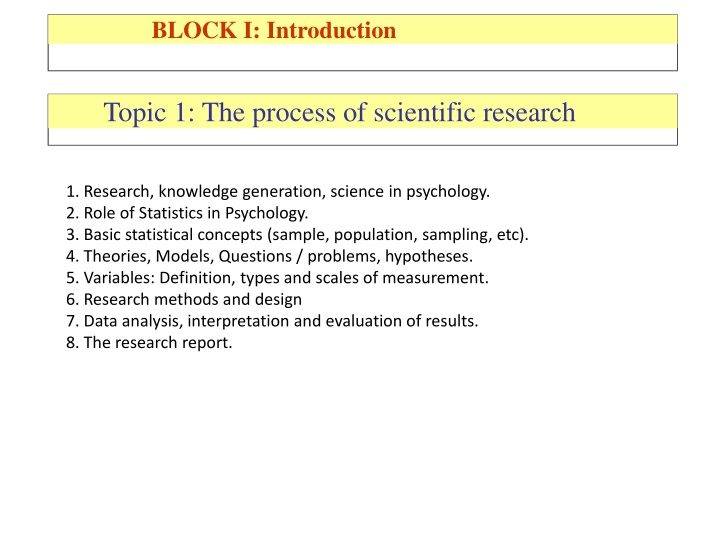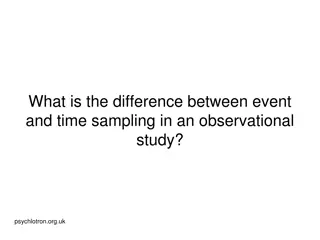Scientific Research in Psychology: Knowledge Generation and Methods
Scientific research in psychology involves the process of knowledge generation through the use of the scientific method. This includes understanding the role of statistics, basic statistical concepts, theories, variables, research methods, data analysis, and the importance of research reports. The content also delves into the objectives of scientific knowledge, the methods of science such as the hypothetical-deductive approach, and the steps involved in conducting research in psychology. Emphasizing validity and replicability, this content highlights the essence of acquiring knowledge through standardized methods in the field of psychology.
Uploaded on Mar 09, 2025 | 0 Views
Download Presentation

Please find below an Image/Link to download the presentation.
The content on the website is provided AS IS for your information and personal use only. It may not be sold, licensed, or shared on other websites without obtaining consent from the author.If you encounter any issues during the download, it is possible that the publisher has removed the file from their server.
You are allowed to download the files provided on this website for personal or commercial use, subject to the condition that they are used lawfully. All files are the property of their respective owners.
The content on the website is provided AS IS for your information and personal use only. It may not be sold, licensed, or shared on other websites without obtaining consent from the author.
E N D
Presentation Transcript
BLOCK I: Introduction Topic 1: The process of scientific research 1. Research, knowledge generation, science in psychology. 2. Role of Statistics in Psychology. 3. Basic statistical concepts (sample, population, sampling, etc). 4. Theories, Models, Questions / problems, hypotheses. 5. Variables: Definition, types and scales of measurement. 6. Research methods and design 7. Data analysis, interpretation and evaluation of results. 8. The research report.
1. Research, knowledge generation, science in psychology. Scientific knowledge: Wealth of information that human beings have acquired over nature and over themselves. Some types of non-scientific knowledge: Common sense (sayings ) Religion (origin of the world ...) Magic (potions ...)
1. Research, knowledge generation, science in psychology. Scientific knowlege: It can be defined in relation to its objectives and the way in which we are trying to achieve these objectives.
1. Research, knowledge generation, science in psychology. Objectives: Scientific knowledge aims to be established in the form of laws as general as possible. How this knowledge is acquired: Scientific knowledge is acquired using a standardized method: the scientific method. One main feature is replicability, allowing consensus within the scientific community.
1. Research, knowledge generation, science in psychology. Method of science: hypothetical-deductive method. Hypothesis: A hypothesis is a predictive announced on the expected outcome of the investigation. Its requires verification and leads to a conclusion Theory: Set of related hypotheses that provide a plausible explanation for a phenomenon or group of phenomena. Inductive method: Reasoning from the particular to the general Deductive method: Reasoning from the general to the particular
1. Research, knowledge generation, science in psychology. Research methods in psychology (I) Steps to examine a research problem: Definition of the problem Deduction of testable hypotheses Establishing a data collection procedure Analysis of the results Discussion of these results Writing a research report
1. Research, knowledge generation, science in psychology. Validity Are the results due to the experimental situation? (Internal validity: When the results are due to the manipulated factors and not from some uncontrolled variables) Can we generalize the results to the "real world"? (External validity: generalizability of the results)
1.2. Funcin de la Estadstica en Psicologa. Role of Statistics in Psychology. Empirical psychological research Data collection Data analysis (Statistics) Phase 1: Exploratory/descriptive analyses (Descriptive statistics) Fase 2: Hypothesis testing (Inferential statistics) Conclusions and generation of new hypotheses
1.2. Funcin de la Estadstica en Psicologa 1.2. Funci n de la Estad stica en Psicolog a. Role of Statistics in Psychology. Mozart Effect Hypothesis (scientific): Subjects who listen to Mozart music improve performance on intelligence tests more than those who do not listen to Mozart. Experiment. Half of the participants (randomly selected) is presented with music of Mozart, the other half are presented chillout music. Then, we conduct an intelligence test. According to the above hypothesis, one would expected differences in intelligence between the two groups. Statistical hypothesis. The null hypothesis (H0) indicates no effect and the "alternative hypothesis" (H1) indicates presence of an effect. The means and standard deviations of the group "Mozart" and the group "chillout" are calculated and the corresponding inference test is performed. We obtained a p value: this indicates how likely is to get the obtained result (or a more extreme result) assuming that the null hypothesis is true. (Notice that the researcher typically wants to reject the null hypothesis.)
1.2. Funcin de la Estadstica en Psicologa 1.2. Funci n de la Estad stica en Psicolog a 1.2. Funci n de la Estad stica en Psicolog a. Role of Statistics in Psychology. Example : Independent variable (the variable that has been manipulated/selected): Type of music (Mozart vs. chillout) Dependent variable (the variable that is being measured;): CI after listening to music N = 10 (Randomization to groups; 5 subjects each group)
Data Group IQ after music Subj. 1 Subj. 2 Subj. 3 Subj. 4 Subj. 5 Subj. 6 Subj. 7 Subj. 8 Subj. 9 Subj. 10 Mozart chillout chillout chillout chillout chillout Mozart Mozart Mozart Mozart 104.00 100.00 102.00 104.00 100.00 106.00 104.00 108.00 109.00 103.00
Results (SPSS) Descriptivos CI Intervalo de confianza pa la media al 95% L mite inferior N Media Desviaci n t pica Error t pico M nimo M ximo ra L mite superior 104.4833 109.1656 106.1593 Chillout Mozart Total 5 5 102.0000 106.0000 104.0000 2.0000 2.5495 3.0185 .8944 1.1402 .9545 99.5167 102.8344 101.8407 100.00 103.00 100.00 104.00 109.00 109.00 10 Sig.<.05; We reject H0, we conclude that there is an effect of music on IQ Inferential test
Basic statistical concepts Population: The set of all elements that share one or more characteristics. We can have a finite population (e.g., psychology students in Spain) or an infinite population (e.g., the set of even numbers). (Normally, we will work with samples.)
Basic statistical concepts Sample: Subset of elements of a population. Objective: To be able to describe the population. To do this, the sample must be representative of its respective population.
Basic statistical concepts Parameter: A descriptive property of the population. They are symbolized with Greek letters ( for the mean, for standard deviation). Statististic: A descriptive property of the sample. They are symbolized with Latin letters (X for the mean, s for standard deviation).
Basic statistical concepts Sampling. In order to generalize the results of the sample to the population, the sample must be representative. Representative sample: A subset of subjects belonging to a particular population. It should have the same general characteristics as the population. Otherwise, we would have a biased sample.
Basic statistical concepts Descriptive analysis: The objective is to characterize, describe and draw conclusions on a sample of data. Inferential analysis: It involves making inferences of the population from the data. IMPORTANT NOTE: The link between both analyses is the theory of probability.
Basic statistical concepts Univariant and Multivariant analyses Univariate analysis: We organize and summarize data, treating each variable in isolation. Multivariate analysis: In this case, we examine the relationship between two or more variables simultaneously.
Theme 1: The process of scientific research 1. Research, knowledge generation, science in psychology. 2. Role of Statistics in Psychology. 3. Basic statistical concepts (sample, population, sampling, etc). 4. Theories, Models, Questions / problems, hypotheses. 5. Variables: Definition, types and scales of measurement. 6. Research methods and designs. 7. Data analysis, interpretation and evaluation of results. 8. The research report.
Theories, Models, Questions / problems, hypotheses. Scienfical theories (taken from Wikipedia): In science, the term "theory" refers to "a well-substantiated explanation of some aspect of the natural world, based on a body of facts that have been repeatedly confirmed through observation and experiment. Theories must also meet further requirements, such as the ability to make falsifiable predictions with consistent accuracy across a broad area of scientific inquiry, and production of strong evidence in favor of the theory from multiple independent sources. The strength of a scientific theory is related to the diversity of phenomena it can explain, which is measured by its ability to make falsifiable predictions with respect to those phenomena. Theories are improved (or replaced by better theories) as more evidence is gathered, so that accuracy in prediction improves over time; this increased accuracy corresponds to an increase in scientific knowledge. Scientists use theories as a foundation to gain further scientific knowledge, as well as to accomplish goals such as inventing technology or curing disease. Example: theory of relativity
Theories, Models, Questions / problems, hypotheses. Definition of Model T akenfromWikipedia: Scientific modelling is a scientific activity, the aim of which is to make a particular part or feature of the world easier to understand, define, quantify, visualize, or simulate by referencing it to existing and usually commonly accepted knowledge. It requires selecting and identifying relevant aspects of a situation in the real world and then using different types of models for different aims, such as conceptual models to better understand, operational models to operationalize, mathematical models to quantify, and graphical models to visualize the subject. Modelling is an essential and inseparable part of scientific activity, and many scientific disciplines have their own ideas about specific types of modelling.
Theories, Models, Questions / problems, hypotheses. Example: G mez, P ., Ratcliff, R., & Perea, M. (2008). The overlap model: A model of letter position coding. Psychological Review, 115, 577- 601.
Theories, Models, Questions / problems, hypotheses. Problem: Question to resolve arising from daily life, practical needs, contradictory results, etc. A sentence, sometimes interrogative, indicating a relationship between variables. One must have creativity and originality, and the question should be interesting and well-constructed Example: The behavioral aspects associated with stuttering (stuttering) are influenced by excessive muscle tension?
Theories, Models, Questions / problems, hypotheses. Hypothesis: A tentative solution that can be tested to determine its truth. Hypotheses must be empirically testable. Hypotheses should be clear and simple in its definition. It is customary to ask them in terms of "if ... then ..." Example: If excessive muscle tension affects the behavioral aspects of stuttering then include treating a muscle relaxant should improve the results of therapy.
. Variables: Definition, types and scales of measurement. Variable: Any characteristic that has more than one category. Type of variables depending on the type of measurement: Manifest variables: When the measurement can be directly measured. Example: reaction time, profession, gender. Latent variable: When the measured cannot be directly measured. They are unobservable characteristics. Example: Intelligence, psychological well-being.
. Variables: Definition, types and scales of measurement. Measurement is the process of attributing numbers to characteristics. Assigning numbers to characteristics is done by following rules (Stevens, 1949).
. Variables: Definition, types and scales of measurement. SCALES in PSYCHOLOGY 1) Nominal Scale: The assigned numbers only serve to distinguish categories. Sex (0 = male, 1 = female). Relationship: same- different 2) Ordinal scale: The numbers indicate not only equality / inequality (nominal scale) but also a relationship of order. Level of German (0 = no knowledge, 1 = A1, 2 = A2, 3 = B1, 4 = B2, 5 = C1, 6 =C2). Relationship: same- different and order
. Variables: Definition, types and scales of measurement. SCALES IN PSYCHOLOGY 3) Interval scales: In this case we already have measurement unit (that is, we know the difference between elements). The origin of the scale is arbitrary. Temperature in degrees Celsius or Fahrenheit. Relationship: same-different order, constant unit 4) Ratio scales. In this case, we have a measurement unit and also an absolute 0. In this case, we have relations of equality / inequality of reasons. Weight, height. Relationship: same-different, order, constant unit, absolute zero.
2.2. Variables: Definicin, tipos y escalas de medida . Variables: Definition, types and scales of measurement. TYPES OF VARIABLES 1) nominal or qualitative Variable (nominal scale) 2) Ordinal or quasi-quantitative Variable (ordinal scale) 3) Quantitative Variable (corresponding to the scale interval or ratio) 3a) Discrete: It only takes isolated values (e.g., number of children) 3b) Continuous: It can take any value within a defined range of values (weight, height, intelligence)
Research methods and design Research Methods in Psychology Experimental Non-experimental or correlational Random groups Natural manip. Experimental Quasiexperimental Surveys Observational methods Qualitative methods
Research methods and design Manipulative-experimental tradition: nomothetic approach: Search of general laws of behavior. The independent variable/s are manipulated to see their/its impact on the dependent variable/s. Determination of causal relationships. Laboratory research controlling for confounding variables.
Research methods and design Correlational-associative tradition Idiographic approach: Evaluation of differences between individuals or groups. Determination of correlations/associations between variables or factors. Field research. Main types of non-experimental research: Survey methodology. observational methodology (case studies). Qualitative Methodology (e.g., interviews).
Research methods and design Survey methodology: Its aim is to describe characteristics of a population fromresponses to surveys or questionnaires. Observational methodology: Its aim is to describe phenomena occurring in natural environments. It is a systematic record of behavior. Qualitative Methodology: Its aim is to describe a phenomenon seeking more meaning than quantification.
Data analysis, interpretation and evaluation of results. Experimental or quasi-experimental methodology: The most common techniques of data analysis consist contrast of means: t-test, ANOVA, etc. Correlational methodology: Pearson coefficient, or association, such as as 2, regression models in which one or more factors are explained are also used from a mathematical function based on other variables or factors (single or multiple linear regression, logistic regression, etc.)
The research report . The last step of any scientific research is the dissemination of the findings so that it is shared with the scientific community. - If there is no diffusion, the research is unknown and therefore with no real impact - How can we do that? Congress: Oral presentations / Posters Scientific journals: - Impact Index: Journals with more impact (Q1).























